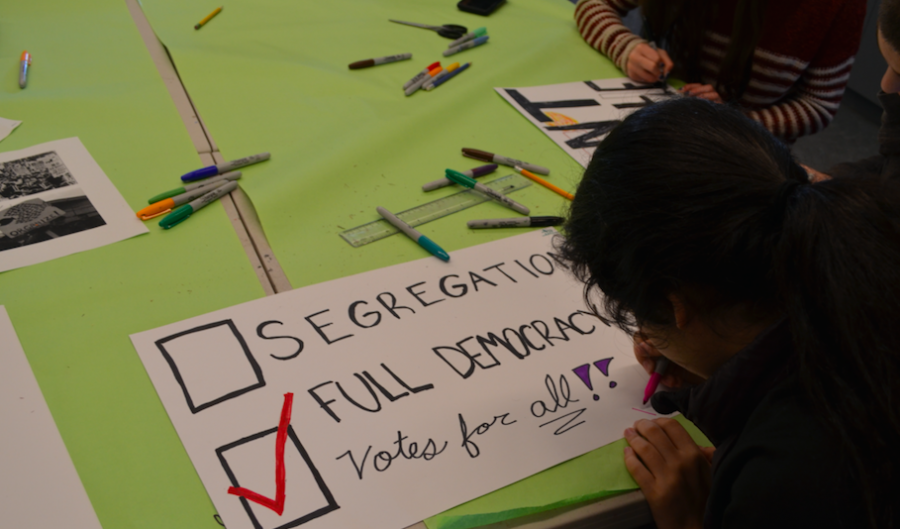OPINION / MLK Holiday: Use the whole day
IMMERSE: Students made posters reflecting values of the Civil Rights era on Martin Luther King, Jr., Day Jan. 16.
February 6, 2017
Wait, we just had school on a national holiday? This year, Shalhevet commemorated Martin Luther King Day by having a normal school day with one hour and 45 minutes cut out for King-related activities.
The third Monday in January — close to the day Dr Martin Luther King Jr. was born, Jan. 15 — was recognized as a national holiday on Nov. 2, 1983, when then-President Ronald Reagan signed a bill to pass it into law. This year it was observed Jan. 16.
It celebrates the work both of Dr. King himself and of other civil rights activists. As President Reagan said, “It is a time for rejoicing and reflecting. We rejoice because in his short life, Dr. King helped to move us closer to the ideals on which America was founded.”
Since it is a federal holiday, public schools are required to have the day off, and while private schools are not, many do.
Three years ago, Shalhevet decided that what Dr. King fought for aligns with Jewish values, so the day could actually be used as a teaching opportunity.
We read in Leviticus Chapter 19, verses 17 and 18, “You shall not hate your kinsman in your heart. Reprove your neighbor, but incur no guilt because of him. You shall not take vengeance or bear a grudge against your kinsfolk. Love your neighbor as yourself: I am Hashem.”
For this reason, says Principal Reb Noam Weissman, the school believes it would be better to learn on this day than to have it off.
While this may be true in theory, it does not yet work in practice. Just having a one-hour-and-40-minute learning period is not enough. When students have classes, still have to do schoolwork, and can be assigned tests and homework, Martin Luther King Jr. Day is barely any more than a regular school day.
If the school really wishes to honor Dr. King and all those who fought for civil rights, the day must be reorganized. The time involved in civil rights study must be increased, and the rest of the day should be cancelled.
This year’s program included a video documenting aspects of the fight for civil rights and activities in which students could immerse themselves in the experience. Some made posters to express a message, others wrote letters to public officials, and some learned about how to use lessons from our ancestors.
It was a good place to start, but we can improve.
In a half-day full of MLK activities like these, we would learn more about the effect ordinary individuals, often including Jews, had on moving our country closer to its ideals.
Planning a full day might be difficult, so a half-day would suffice, and teachers would be forbidden from assigning any work or tests. This would make a greater impression of the day’s importance — as President Reagan envisioned — and also let the lessons we learned settle more in our minds.
If even a half-day is too difficult to arrange, then Shalhevet must give students the full day off. The school cannot claim to be celebrating the holiday while also having regular classes.
Some say that having any-length MLK activity is better than students doing whatever they wanted at home. Perhaps students would not even think about the meaning of the day if they did not have school. This would likely be the case for most students at Shalhevet.
But if this event is merely a portion of an otherwise mundane day, lessons learned will be too quickly forgotten. We all benefit from Dr. King’s accomplishments, and using the entire holiday as an occasion to teach students about them is the way to make an impact that will last.
By learning of the injustices that civil rights leaders fought against, and of the extraordinary obstacles they overcame, we can combine our Jewish ideals at Shalhevet with an American sense of righteousness. A half-day of learning thus would accomplish both the goals of the administration and those of the holiday.














